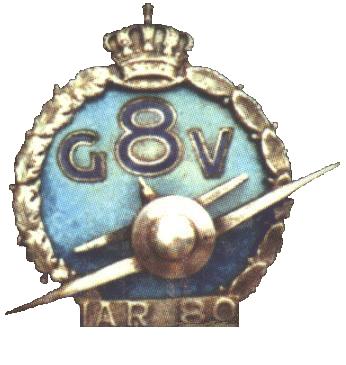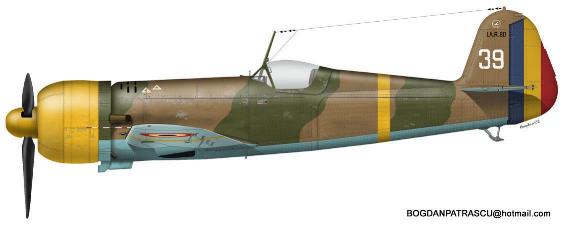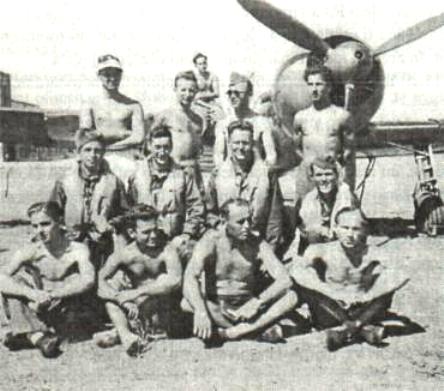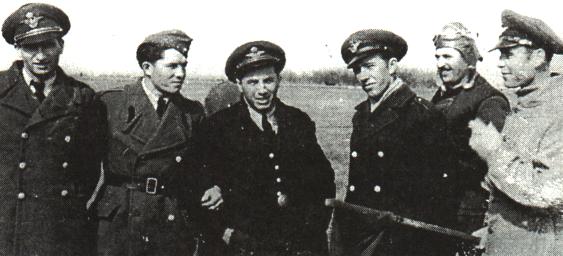|

8th Fighter Group pilot badge
The 8th Fighter Group was formed on 22 February 1941 by the 2nd Fighter Flotilla. It was
commanded by lt. cdor. av. Gheorghe Bordeanu. It was the first unit equipped with the new
IAR-80 fighter. The group was made up of the 59th and 60th Fighter Squadron and was
stationed on the Râmnicu Sărat airfield.

Profile courtesy of
Bogdan Patrascu
This IAR-80 that belonged to the 8th Fighter Group has the old roundel
markings
On 22 June 1941, the unit had 23 aircraft available for action and one unavailable.
The 8th Fighter Group's first mission of the day (and of the war) was carried out by
16 IAR-80s which escorted S-79 bombers to Bolgrad and Bulgarica. They engaged in a dogfight
with Soviet fighters, but didn't manage to shoot down any of them. The same happened the
next days. The first victories came on 27 June, when four I-16s were claimed by the group's
pilots. The first casualty was slt. Gaston Dan, who was shot down the same day.
On 2 July, cpt. cdor. av. Eugen "Puiu" Pârvulescu took over the command. The 41st Fighter Squadron joined the group.
More victories followed. The next day an IAR-80 celulă (Rotte) made up from
adj. sef av. Stefan Pucas and adj. av. Nicolae Tcaci took off quickly and intercepted three
Soviet SB bombers which have just raided the airfield near Râmnicu Sărat and shot down
all of them.
The day of 12 July was very successful for the fighters of the 8th Group. They managed
to shoot down four I-16s. A fifth was brought down by slt. av. Vasile Claru through ramming. He was killed in the crash and later was the first 8th Fighter Group pilot to be rewarded with the highest Romanian decoration: the Mihai Viteazul Order 3rd class.
On 20 July, the 59th Squadron was detached to the Mamaia airfield, where it replaced
the 53rd, while the other two (41st and 60th) were moved to Bârlad. On 15 August the
42/52nd Squadron (also equipped with IAR-80s) replaced the 59th.
The group was already engaged in the brutal Battle of Odessa and carried out many bomber
escort, free-hunting and armed reconnaissance missions. On 14 August eight of the group's
IAR-80s raided the seaplane base at Hadjibey and achieved total surprise. The AAA was
silent and they managed to destroy 3 and damage another 3 of the 7 Soviet aircraft
there.
The 8th Fighter Group's fighters had a field day on 23 August. During the third mission
10 IAR-80s intercepted 5 Soviet bombers escorted by 12 I-16s. The DB-3s immediately dropped
their bombs and turned back. While the other IARs engaged the fighters, adj. av. Dumitru Ilie attacked the bombers and shot down one. The others bagged 4 Ratas. Another two Ratas were shot later in the 4th mission of the day bringing the total to seven airplanes.

Picture from "Vanatorul IAR-80, istoria unui erou necunoscut" by
Dan Antoniu & George Cicos, MODELISM, 2000
The pilots of the 42/52nd Fighter Squadron
On 25 August, two IAR-80 patrule (Romanian for Schwarm) were escorting a bomber formation to Odessa and engaged several I-16s trying t oojntercept them. In the following dogfight, 3 VVS fighters were shot down, two of which by future aces of the 8th Fighter Group: lt. av. Ion Micu and adj. av. Florian Budu. Later that day, lt. av. Florin Alexiu led a lowlevel attack on the seaplane base at Kuzhdnyk Liman, during which three flying boats were destoyed on the lake. Two of these were claimed by the formation leader.
At the end of August, the 59th Squadron returned to the group and the 42/52nd left it. By this time, the 8th Fighter Group had flown 168 missions and claimed 56 aircraft destroyed in the air and on the ground, while losing 3 pilots in action.
Another great day of the group was 7 September. In the morning eight airplanes strafed
the VVS airfield at Sukhoy Liman but destroyed only a bomber which was already under
repairs. Later, at noon, an IAR-80 patrulă escorted 6 S-79Bs near Odessa.
They were attacked by 8-10 I-16s. In the following dogfight, two Ratas were claimed by the
Romanian pilots, but they weren't confirmed. Another two patrule were on a
free-hunting mission and encountered 15 I-16s. They claimed 9 Soviets, but only 6 were
confirmed. Four belonged to adj. sef av. Ioan Rădulescu and adj. av. Teodor Zăbavă each with two victories. In the afternoon four IAR-80s were escorting 5 Potez-633B2s to a bomb Frankfeld. They were attacked by 11 I-16s, but shot down 3 of them. In the same time other two patrule escorted other Potez-633s and P.37Bs in other bombing raids. They did not encounter any enemy aircraft and strafed Soviet ground troops.
On 30 September the group moved to the airfield at Salz. This was also the day when the
8th Fighter Group's pilots scored their last kills during the 1941 campaign: 4 I-16s. On
6 October the first six IAR-81s entered active duty, but their first mission was on
15 October, when 5 of them, under the command of lt. cdor. av. Gheorghe Bordeanu, dive bombed the Odessa harbor area without many results. The next day, Bordeanu led his dive bombers again against the harbor and managed to hit two ships. On the same day Romanian troops entered in the city and the 1941 campaign was practically over for the 8th Fighter
Group. It returned to Romania on the Târgsor airfield, in the Ploesti area. It was one of
the most successful Romanian fighter units in 1941 with over 75 confirmed victories,
5 probable and 10 on the ground. The group's top scoring ace was adj. av. Teodor Zăbavă with six kills.
The spring and summer of 1942 were used for intensive target practice and exercises of
co-operation with friendly AA artillery against air raids. Despite these, the first
USAAF raid, Operation Halpro (12 June 1942), created a lot of confusion among the defenders. At 0400 hours, as
a few of the 13 Liberators passed over Târgsor airfield. The alarm patrulă from
the 41st Fighter Squadron took off to intercept them. They followed them through the flak
and got separated. Adj. av. av. Vasile Pascu cought up with one bomber, together with a German fighter. They both fired on it and they saw it go down. From the 42nd (which had joined the group in 1942) only one airplane took off and didn't encounter anything. The same happened with one of the two celule from the 60th Squadron. The other one intercepted a B-24 and engaged it. However, they fired from distance all their ammo without effect. Another 7 fighters were scrambled, but didn't spot any enemies or couldn't catch up with them, because of the big distance.
On 3 September the 8th Fighter Group started its journey to the front at Stalingrad and
arrived there on 7, with the 41st, 42nd and 60th Fighter Squadron. The 59th was detached to
the defense of Ploesti and remained in Romania. The first missions from the airfield at
Tusov where flown on 9 September and the first victory of the campaign came the next day,
when cpt. av. Traian Gavriliu shot down a Yak-1.
More came the next days. On 12 they claimed 7, but only 3 were confirmed. 17 September
was a busy day. Early in the morning, a patrulă escorted a German bomber formation.
They were attacked by 4 Yaks. In the following dogfight, adj. stg. Florian Budu, a five
victory ace from the 1941 campaign, managed to shoot down one of them. Later that day,
the same mission and same outcome: one Yak shot down. In the afternoon, another IAR-80
patrulă spotted a Soviet bomber formation escorted by 10-12 Yaks. They attacked the
bombers and determined them to turn around. One of the Pe-2s was shot down. Cpt. av. Emil Droc added a MiG-3 to the overall day score. That night, about 8 Soviet bombers paid a visit to the 8th Fighter Group, but only managed to lightly damage an airplane. They came back the next day and destroyed an IAR-80 and wounded two pilots on the ground.

Picture from "Vanatorul IAR-80, istoria unui erou necunoscut" by
Dan Antoniu & George Cicos, MODELISM, 2000
Pilots from the 8th Fighter Group at Stalingrad
Another day with intense activity for the pilots of the 8th Fighter Group in
1942 was 30 October. They flew mostly escort missions with Romanian He-111s and JRS-79Bs,
but also free-hunting missions. In total they managed to shoot down 6 VVS fighters.
On 8 November the 60th Squadron moved to Bakonskaya for winter.
After the start of the Soviet offensive, the situation of the ground troops called for
support from the air, despite the extreme weather conditions. In December the 8th Fighter
Group flew numerous bomber escort and armed reconnaissance missions, until 21 December
when the 41st and 42nd Squadrons started to prepare to move to Rostov. On 31 December they
started to return home.
During the second campaign of ARR, the 8th Fighter Group was on the front for about 90
days. It made 668 sorties in 196 missions (94 bomber escort, 71 free-hunting, 27 airfield
defense, 4 reconnaissance) and achieved only 15 confirmed victories in 10 dogfights. It
lost 3 airplanes, which were destroyed on the ground by Soviet bombers. The overall ace of the two campaigns in the group was teh same adj. av. Teodor Zabava with 11 confirmed kills.
These were the last fights of the 8th Fighter Group. On 11 May 1943 it was decided to reequip the unit with Hs-129B2s. Thus the 8th Fighter Group became the 8th Assault Group, but that's another story... |